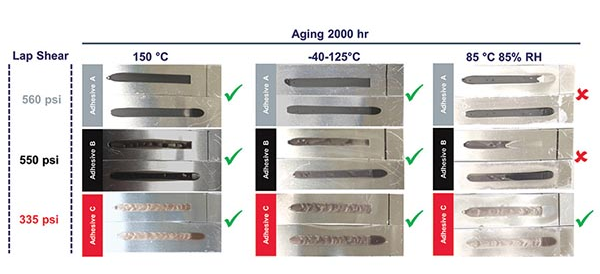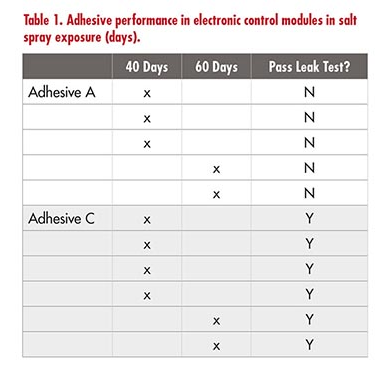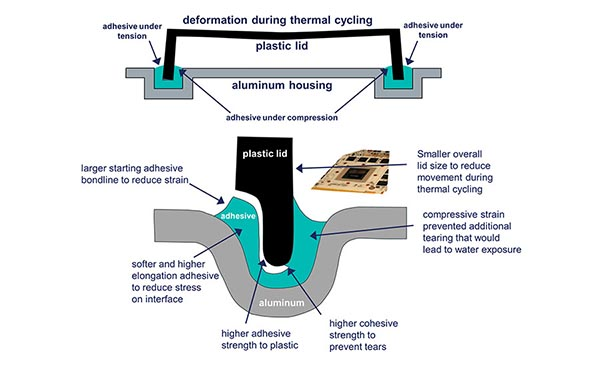Silicone adhesives for extended use of electric vehicles
![]()
Silicones to extend the life of electronic modules in electric vehicles
In battery electric vehicles (BEVs) and autonomous vehicles, on-board electronics regulate critical areas such as driving control units, safety systems, proximity sensors and connectivity controllers. The electronics in these increasingly sophisticated computers are susceptible to corrosion failures due to exposure to water and salt during vehicle operation, which can lead to performance problems, loss of function and costly repairs.
To protect these electronic components, automotive electronics suppliers often use liquid adhesives or sealants that cure in place. However, suppliers need to differentiate between several types of products in order to select effective solutions to permanently protect critical systems for many years of service.
Figure 1. On-board electronics are protected by a variety of silicone adhesive solutions
Silicones to protect on-board electronics
Silicones are consistently emerging as a class of materials of choice for providing lifetime protection against environmental stresses due to their inherent chemical stability and stress-reducing mechanical flexibility (see Figure 1). At their core, silicones have a chemical backbone of silicon-oxygen bonds similar to those of glass, making them inherently durable in the face of severe environmental stresses, including temperature extremes and cycling, UV exposure, cyclical changes in humidity and water immersion.
Silicone solutions also remain elastic and flexible even under these harsh conditions, which relieves interfacial stresses in adhesive joints and also allows for small movements, preventing joint fatigue for years, even decades, of the electronic part. In addition, silicone adhesives are formulated to remove heat from printed circuit boards through the incorporation of thermally conductive additives. The incorporation of electrically conductive additives allows for grounding and electromagnetic shielding of critical systems without sacrificing short or long-term adhesive properties.
Advanced electronic control modules typically use aluminium alloys and special resins for their housings and connectors. These disparate substrates must be assembled in a watertight manner to prevent moisture penetration and protect the electronic components. Adhesive joints must be durable enough to withstand repeated mechanical and environmental stress. Figure 2 shows an example of an electronic component joint filled with a flexible silicone adhesive that eliminates the possibility of water intrusion.
![]()
Figure 2: Example of a silicone seal in an electronic transport module.
Curing of silicone adhesives adapted to production needs
Silicone adhesives and sealants are formulated with a range of curing mechanisms to meet manufacturing, supply chain and performance needs (see Figure 3). Room temperature adhesives (RTVs), for example, cure by exposure to water vapour in air. Curing occurs when water vapour diffuses into the material and the alcohol vapour leaves the material as a result of the condensation reaction of the alkoxy moieties with water. This type of curing results in excellent adhesion to metals, metal alloys, glasses and ceramics, as well as many plastics.
![]()
No additional curing equipment is required for RTV adhesives, so they offer excellent durability due to their low energy consumption. Cure times, typically in the order of several days, can be a logistical challenge in some supply chains if parts need to be tested, handled or shipped immediately after assembly or before the silicone adhesive has sufficiently cured. As a result, an innovative trend among adhesive developers is to reduce cure times from hours or days to minutes. Another method of curing silicones that is well established in the automotive industry is heat curing. In this case, curing takes place in a large chamber oven or conveyor oven, which typically requires a contact temperature of 130-150°C. The curing takes place by platinum-catalysed hydrosilylation reactions. A typical thermosetting silicone adhesive requires 30-60 minutes of high temperature exposure to cure and strengthen adhesion to various substrates. This reaction generates no rejects or residues, and parts can be immediately tested, handled and shipped after cooling.
Thermoset adhesives adhere to a wider range of plastics than room temperature thermosets, due to the energy added during heating. However, the high temperatures required for curing can be limiting for some temperature sensitive surfaces or electronic components of the module. Therefore, innovative materials for this type of curing are designed to cure faster to reduce the time spent at high temperatures and to enhance adhesion at lower temperatures (e.g. 80°C).
UV or photocrosslinking technology is gaining interest as hybrid organosiloxanes combine near-instantaneous crosslinking due to photocrosslinkable groups with the inherent stability of silicones. This type of curing is attractive because of the distinct “on-off” control of light exposure, low energy consumption and high speed (only a few seconds). The downside is that the curing process only takes place in the areas visible to the light. To fully cure the shadow areas, a secondary cure is added. The material exposed to UV light cures in a few seconds and the shadow areas cure for a longer time due to the secondary curing mechanism.
The final type of curing is reactive silicone hot-melt technology, where the formulation is initially solid at room temperature. It is then heated to allow flow and is dispensed onto the part. The parts are assembled before the adhesive cools to produce instant adhesive strength, commonly referred to as green strength. This method of dispensing requires a heated dispensing unit and careful planning of the operational workflow to ensure that products are assembled in a timely manner after dispensing. This type of heating requires much less energy than that required to heat an entire oven. The silicone adhesive develops additional bond strength with secondary curing over time through the RTV curing mechanism mentioned earlier.
Some examples of products :
| References | Description | Curing | Application |
| Dowsil™ 1-4173 | Grey thermally conductive adhesive | HTV | Battery pack |
| Dowsil™ SE 4485 | White thermally conductive adhesive | RTV | Battery pack |
| Dowsil™ SE 9168 | One part grey adhesive | RTV | Assembly |
| Dowsil™ EA-4700 | Two-part grey adhesive | RTV ou HTV | Assembly |
| Dowsil™ 7091 | One-part sealant (grey, black or white) | RTV | Protection |
| Dowsil™ Q1-9226 | Grey thermally conductive adhesive | HTV | Inverter / converter & control unit thermla management, PTC heater |
| Dowsil™ TC 2030 | Two-part thermally conductive adhesive | HTV | Inverter / converter & control unit thermla management |
| Dowsil™ 3-6265 | Black thermally conductive adhesive | HTV | Assembly (on board charger, inverter converter) |
| Dowsil™ HM 2510 | Hot Melt | Hot melt | Assembly |
| Dowsil™ 3-6371 | Silicone Gel (UC cure) | UV | Encapsulation of PBC |
| Dowsil™ VE-6001 | Adhesive UV | UV | Designed to bond display cover glass/plastic and touch panel to LCD/OLED display module |
Adhesive selection and application specific testing
Working with a materials supplier early in the development phase of an electronic module regarding adhesive selection can significantly improve validation test success rates and final module performance. For example, small changes in the design of the bond line thickness of an adhesive joint can significantly reduce the expected mechanical stress on the adhesive and the joint, which will increase longevity.
In addition, some adhesive curing techniques are better suited to the durable performance of the adhesive on specific resin grades, which may not be obvious from the product literature. Although the data sheets provide basic comparisons of material performance, the values given do not necessarily correlate with durable performance. Over-reliance on the bond strength or shear strength values in the data sheets, for example, can lead to delayed validation cycles or even field failures if the durability of the bond on the specific substrates is not properly assessed.
Adhesion tests should therefore reflect the actual stresses experienced by the adhesive over the life of the device, such as low but constant or cyclic stresses and changes in environmental conditions. Specifically, adhesion durability tests (e.g., the wedge fracture test) that closely mimic actual joint conditions are better predictors of lifetime performance than purely strength-based tests. Unlike laboratory strength tests such as shear or peel, bond durability tests provide information about a joint subjected to a constant but low mechanical stress, mimicking the stresses that occur in the field. In addition to the constant mechanical stress, the samples are also exposed to environmental ageing conditions such as thermal cycling, water submersion and salt spray cycles.
Figure 4 shows durability samples of the wedges that were opened after 2000 hours of ageing under the expected environmental conditions. Three silicone adhesives were compared. All three adhesives show no failure in the high heat (150°C) or thermal cycling (-40-125°C) tests, highlighting the excellent thermal stability of silicone adhesives. However, when exposed to the combined stresses of mechanical deformation, high heat and high humidity, adhesives A and B failed after only 250 hours of environmental exposure. These adhesive failures could create a path for water to penetrate the modules, leading to corrosion of the electronics.

Adhesive C does not fail after 2000 hours of ageing under all conditions. It is important to note that the adhesion value to aluminium provided in a data sheet is the lowest for Adhesive C compared to the other adhesives.
To illustrate the ability of durability testing to predict actual application performance, Adhesives A and C were used to seal fully assembled electronic control modules which were then subjected to 40 and 60 days of automotive salt spray using an aggressive OEM method. The modules required a seal between a stamped aluminium cover and a cast aluminium housing. The steps in the standard include:
- Mounting the component in its intended final orientation
- Soak in a 70°C chamber for 1 hour.
- Adjust to 35°C; spray with 5% salt solution for 1 hour.
- Stop salt spray; allow chamber to cool to room temperature for 1 hour.
- Repeat steps 2-3 three times for a total of 9 hours.
- 15 hours at room temperature; uncontrolled humidity and no salt spray.
- 24 hour sequence repeated for desired number of cycles.
After sealing, all modules assembled with both adhesives passed the initial air pressure leakage tests before being subjected to the salt spray cycle. As can be seen in Table 1, all modules sealed with Adhesive A failed the 40 and 60 day salt spray tests, but all modules sealed with Adhesive C passed the aggressive tests.

The data sheet values for bond strength to aluminium for Adhesive A (560 psi) and Adhesive C (335 psi) were not predictive of application performance. However, as can be seen in Figure 4, evaluation of both adhesives using aged corner durability samples under application conditions, which included combined mechanical and environmental stresses, was highly correlated with the performance of the adhesives in the final module.
Specific application requirements
In addition to selecting an appropriate curing method and conducting durability tests relevant to the application, working with a material supplier who understands the application requirements is an essential step in quickly achieving a reliable adhesive solution and assembly. For example, an adhesive seal in a customer’s electronic module had a failure that was visually observed after a thermal cycle. The adhesive was delaminating from the plastic cover and partially tearing as it aged.
Figure 5 shows a simplified diagram of the seal and the cause of the deformation. During thermal cycling, the expansion and contraction of the plastic cover causes tension and compression forces on the adhesive that result in both adhesive failure by the plastic and some cohesive failure or tearing of the adhesive. Technical recommendations to solve the problem are as follows:
- Increase the space for the starting bond line to reduce the stress on the joint.
- Use a softer adhesive with higher elongation to reduce interfacial stress at the plastic cover.
- Increase the bond strength according to the specific quality of the plastic used for the lid.
- Increase the cohesive strength of the adhesive to avoid cohesive tears under stress.
- Use a smaller lid size to reduce the total stretch or stress on the joint and improve stability.
Module seal design, adhesive selection, substrate choice and the combined mechanical and environmental stresses in the field all impact the longevity of an electronic component’s protective seal. The success rate of producing modules that hold up over the expected life of the vehicle improves dramatically when inherently durable materials are selected, cure chemistry is matched to the right substrates, and the focus is on application-specific performance goals rather than just data sheet values.

Figure 5: Forces acting on a joint and examples of technical solutions to address failures.
A partnership for success
The mobility and transportation industry is undergoing dramatic changes as electric vehicle and autonomous driving technology advances. A partnership with an adhesive manufacturer is helping to define the adhesive material requirements that enable innovations to meet the high lifetime performance requirements in these applications.
More information :
Needs information on les silicones or Dowsil™ ? Contact our technical service by phone to : +33 426 680 680 or fill our contact form.
Download our dedicated brochures :

Sources : www.dge-europe.com